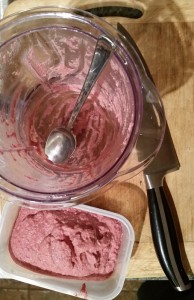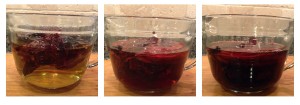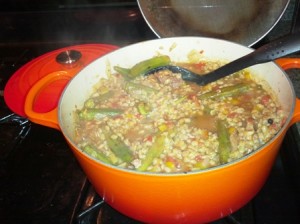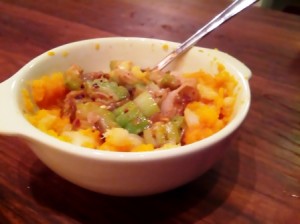As sometimes happens, I was unable to stop myself. I didn’t need ground meat of any kind – I’m more of a whole-animal-parts guy – but it was there. Ground venison. I had to. The problem being, of course, that there’s no way I’m wasting that in a burger or ragu or whatever that’s going to totally just treat it like any other unidentifiable ground critter.
Googling around, I came across this recipe for Korean style ground venison that looked like a nice way to get the needed fat and salt into the meat but also let its essential woodsy-ness come though. Also unable to help myself, I made a few adjustments.
1 pound ground venison
2″ fresh ginger
4 cloves garlic
1″ fresh tumeric root plus an extra couple slices for later
2 squeezes of raw agave nectar
1/4 c low-sodium soy sauce mixed in 1/4 c water
About 6 grams of coconut oil (maybe 1/2 tsp?)
(Other stuff I’ll explain in a second…)
1/2 a sweet onion
1 jalapeno (diced)
1/2 lb shitakes (clean and slice to taste)
3-4 scallions (just the greens)
Slice the onion and start it slowly caramelizing.
Puree the ginger, garlic, and tumeric in a blender (except the extra slices). Brown the meat, add the spice mix, agave, and soy water. When the meat is almost cooked, add the ‘extra’ tumeric, finely diced. When all done, careful not to overcook, remove it to a bowl with a slotted spoon or mesh strainer.
Now, your onions should be nice and caramelized. Add them, the mushrooms, and the jalapeno. Sautee that until done (just a few minutes), and remove with your slotted spoon to a serving plate. Plate the meat with the mushrooms (I did side-by-side, as you can see), and then jack up the heat under the remaining juices to create a glaze. Pour the glaze over both sides of the dish, and serve, topped with sliced scallion greens.
It’s also low-carb and gluten-free and all that if you’re neurotic, but I ate the leftover meat with forbidden rice, and it was awesome too.
Enjoy!!
-MAW





 Guest blogger Maya reports great success with this family recipe – however, she warns that you *really* need to take your time with this, especially taking care to cook slowly and not let things burn. Indian cuisine, she reminds us, requires constant attention and no multi-tasking.
Guest blogger Maya reports great success with this family recipe – however, she warns that you *really* need to take your time with this, especially taking care to cook slowly and not let things burn. Indian cuisine, she reminds us, requires constant attention and no multi-tasking.





